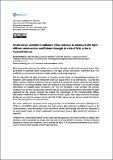Por favor, use este identificador para citar o enlazar a este item:
http://hdl.handle.net/10261/259356COMPARTIR / EXPORTAR:
 SHARE
BASE SHARE
BASE
|
|
| Visualizar otros formatos: MARC | Dublin Core | RDF | ORE | MODS | METS | DIDL | DATACITE | |

| Título: | Underwater annular irradiance: New concept to measure the light diffuse attenuation coefficient through the KduSTICK, a Do-It-Yourself device |
Autor: | Rodero García, Carlos CSIC ORCID ; Bardají, Raúl CSIC ORCID CVN ; Salvador, Joaquín CSIC ; Olmedo, Estrella CSIC ORCID ; Piera, Jaume CSIC ORCID | Fecha de publicación: | 26-abr-2021 | Editor: | European Geosciences Union | Citación: | European Geosciences Union General Assembly (2021) | Resumen: | Measuring water transparency allows us to monitor the water body's environmental status. One parameter to estimate water transparency is the light diffuse attenuation coefficient (Kd). This coefficient is of particular interest in water quality monitoring programs. The Kd describes the light extinction as function as the depth of downwelling irradiance, Ed. However, self-shading by the instrument itself can cause errors in Ed estimations. To avoid this effect, relative complex structures must be required to install the sensors that limit the vertical resolution of Ed measurements. Here we propose to use optical sensors in an annular-shape distribution to mitigate these limitations. For this, we introduce a new concept: the annular irradiance, Ea. We first compute the optimal angle to avoid self-shading while maximizing the light captured by the sensor. Second, we assess the robustness of the corresponding diffuse attenuation coefficient, Ka, in different scenarios of water types, solar angle and cloud coverage. Finally, we correlate Ka measurements with Kd at PAR region, and we derive empirical functions from translating Ka to Kd measurements. This new coefficient is the basis of the new generation of the KdUINO instrument (Bardaji et al., 2016) as a KduSTICK, which estimates the near-surface light extinction coefficient based on Ka measurements. Since the design of the instrument avoids self-shading, the device is expected to be particularly useful in those underwater environments where high vertical Ed resolution is required. Furthermore, instruments based on this light-sensing approach are much simpler to deploy and maintain, and it is possible to design low-cost and Do-It-Yourself (DIY) versions. All these features facilitate its use for non-academic users, making the KduSTICK an optimal instrument to be used in Citizen Science water quality monitoring programs | Descripción: | European Geosciences Union (EGU) General Assembly, 19-30 Apr 2021.-- 1 page | Versión del editor: | https://doi.org/10.5194/egusphere-egu21-9421 | URI: | http://hdl.handle.net/10261/259356 | DOI: | 10.5194/egusphere-egu21-9421 |
| Aparece en las colecciones: | (ICM) Comunicaciones congresos (UTM) Comunicaciones congresos |
Ficheros en este ítem:
| Fichero | Descripción | Tamaño | Formato | |
|---|---|---|---|---|
| Rodero_et_al_2021.pdf | 276,11 kB | Adobe PDF |  Visualizar/Abrir | |
| Rodero_et_al_2021_presentation.pdf | 4,01 MB | Adobe PDF |  Visualizar/Abrir |
CORE Recommender
Page view(s)
67
checked on 24-abr-2024
Download(s)
79
checked on 24-abr-2024
Google ScholarTM
Check
Altmetric
Altmetric
Este item está licenciado bajo una Licencia Creative Commons

